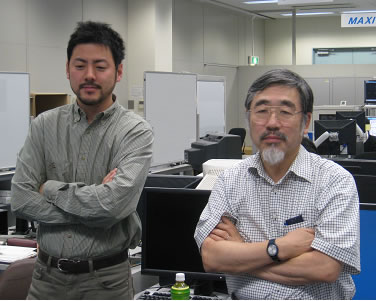This is an archive of information released in the past.
Disclaimer: It may contain broken links or outdated information. Some parts may not function in current web browsers.
*Visit https://humans-in-space.jaxa.jp/en/ for the latest information.

Experiment
- News
- Kibo Utilization Strategy
- Kibo Utilization Plan
- List of JAXA's Utilization Themes
- Experiment Facilities
- Space Environment Utilization
- Archive
Marangoni UVP/MaranGogniat-1 Begins
* All times are Japan Standard Time (JST)
Spatio-temporal Flow Structure in Marangoni Convection-1 (Marangoni UVP/MaranGogniat-1)*, which uses the Fluid Physics Experiment Facility (FPEF) in Kibo, began.
* Principal Investigator: Shinichi Yoda, Professor, Institute of Space and Astronautical Science (ISAS)
The Marangoni UVP/MaranGogniat-1 began at 6:37 a.m. January 29, 2010, after checkout of the FPEF from the Tsukuba Space Center (TKSC) was completed.
JAXA's Marangoni convection experiment tries to make a 5cm-diameter liquid bridge made of silicon oil to measure the convection inside of the liquid bridge with the Ultrasonic Velocity Profiler (UVP) that uses Doppler effect in ultrasound images. The experiment investigates the surface flow rate, temperature distributions, and change in internal flow of a liquid bridge in a microgravity condition.
Marangoni UVP/MaranGogniat consists series 1 and 2. The experiment will continue until July 2010.
Special Message from Principal Investigator (PI)
This project was selected 16 years ago. I am full of emotion because we could finally see the experiment being performed on orbit. Marangoni convection experiment is the most frequently-performed fluid science experiment in space. Until today, more than 40 Marangoni convection experiments have been conducted in space. Japan conducted five of those using the TR-IA mini-rocket, and Japan has made great contributions in the study to characterize mechanisms of Marangoni convection.
Generally, the biggest question in Marangoni convection phenomena is how to establish a similarity rule for transition process of oscillatory flow. Systematic data, which are expected to solve this question, have not been obtained from the past Marangoni experiments in space. JAXA's Marangoni experiments focus on this question, which have been unsolved for more than 20 years. In the past, our team has been trying to systematically establish a similarity rule for transition of the oscillatory flow using data of various different Marangoni convection researches being prepared for microgravity experiment.
The Marangoni UVP/MaranGogniat uses the UVP, which is developed by Professor Takeda (Hokkaido University). The UVP is expected to collect unprecedented data, such as slight changes in the flow, spatio-temporal images of transitions and growth processes of the flow. The project will examine the convection's transition mechanism based on results of this experiment and JAXA's another Marangoni experiment (MEIS), which was performed in 2009.

Yasushi Takeda (Professor of Hokkaido University)(right) and
Yuji Tasaka (Associate Professor of Hokkaido University)(left)
monitoring setup of the experiment from the UOA

Liquid bridge formed during the experiment
*All times are Japan Standard Time (JST)
| Copyright 2007 Japan Aerospace Exploration Agency | Site Policy |